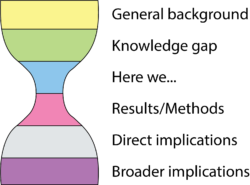Criteria for Success
- What/How? Succinctly describe your body of data and how it was gathered
- So What? Tell a cohesive story that links your findings to defined implications that your readers will care about
- For Who? Contextualize your message for a specific target audience
Structure Diagram
Most successful journal articles share a specific structure, one that builds a cohesive framework for what you have found and why it matters. In the Comm Lab, we like to call this formulaic structure the “Hourglass”:

Following the shape of the hourglass, you should start broad in scope—framing your work in a context that every reader will care about—before zooming in on the specific gap in the field that motivates your research. After detailing your specific findings, zoom back out by connecting your results to both immediate and future implications.
It is often easiest to answer the “What” and “How” of your work in a journal article—abiding by the Hourglass ensures that you answer “Why” and “So What” to the same extent. It’s often these types of answers that mark a memorable and thought-provoking paper.
Identify your purpose
All journal articles share similar goals to a certain extent. Every author should aim to clearly and succinctly describe their findings within the context of a larger story, one that clearly and logically contextualizes the broader impacts of the work. Beyond this, however, you may have more specific goals in mind, which may differ from those of your colleagues and might even change between different papers you write. Ask yourself what is most important to accomplish with this article—are you trying to get the broadest set of eyes possible on your work? Hoping to convince others in the field to use the new technique that you invented? Looking to provoke direct follow-up studies that extend from your work? Think about these specific goals early and often, as they can vastly change how and what you write, from focal points in the introduction or discussion to which specific datasets you choose to highlight in your main figures. In addition, your target journal might prescribe specific goals, so be sure to check the “Aims and Scope” section published by most journals (e.g. Nature Communications), as well as the relevant “Article Types” section for your paper (e.g. types of articles in the journal Immunity), both of which often hint at general objectives in the eyes of the journal that should drive your writing.
Analyze your audience
The last key factor to consider in writing your paper is who will be reading it. Writing for a specific target audience can be hugely impactful on overall clarity and aids in building a convincing overall message or claim. Similar to above, leaning on the “Aims and Scope” of your target journal is often helpful in identifying a target audience. The journal’s scope—from general science to a specific field to a subspecialty within that field—should inform the scope of your paper. The definition of your target audience should then feed directly into how you write your paper. As you write, continually ask “what does this audience care about?” Which results you choose to highlight, what broader implications you choose to focus on, and the breadth of your introduction will likely all depend on the answer to this question.
Skills
As you begin to write the different sections of your paper, read more about each here:
